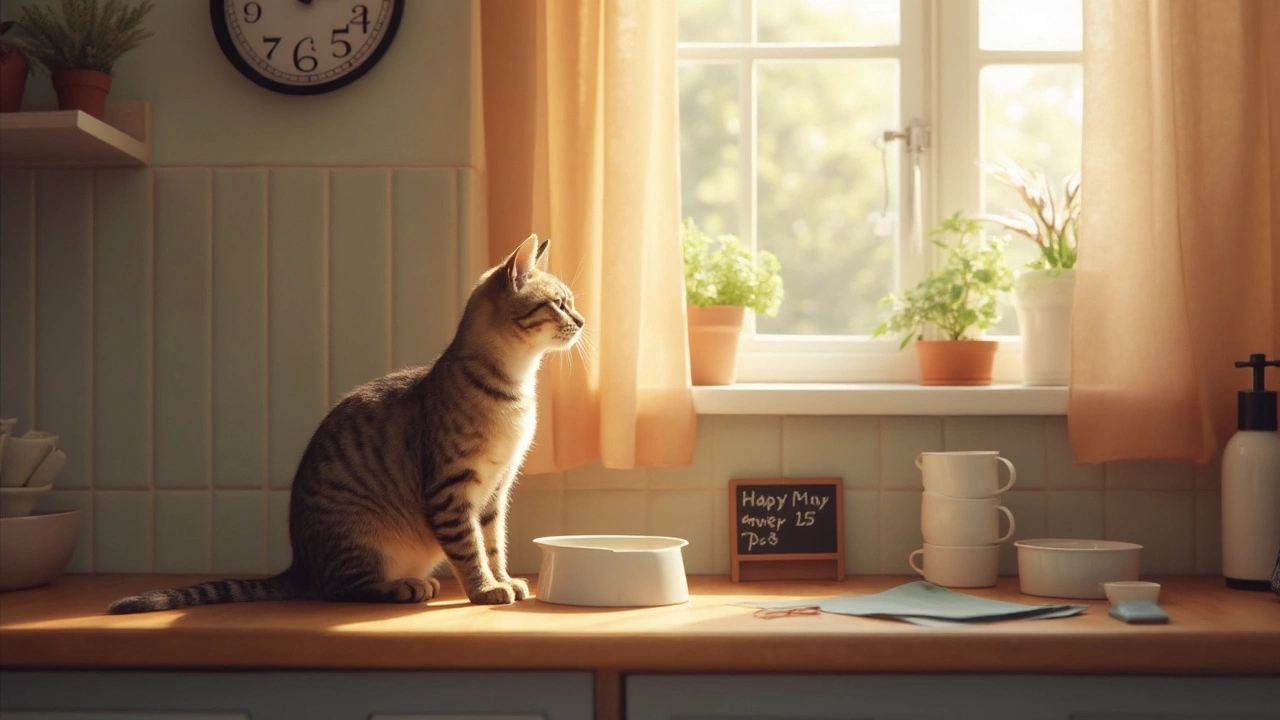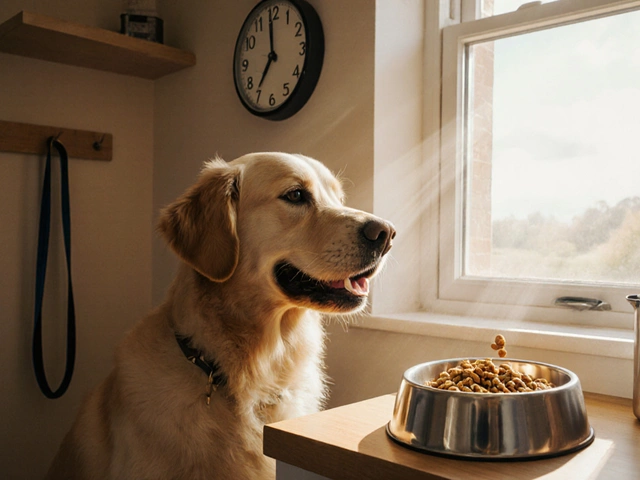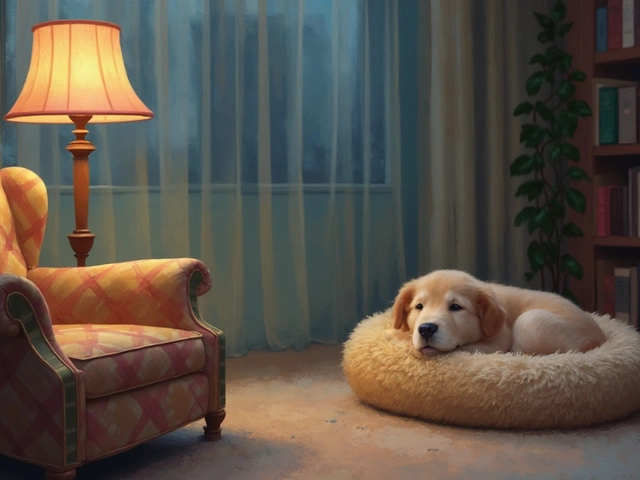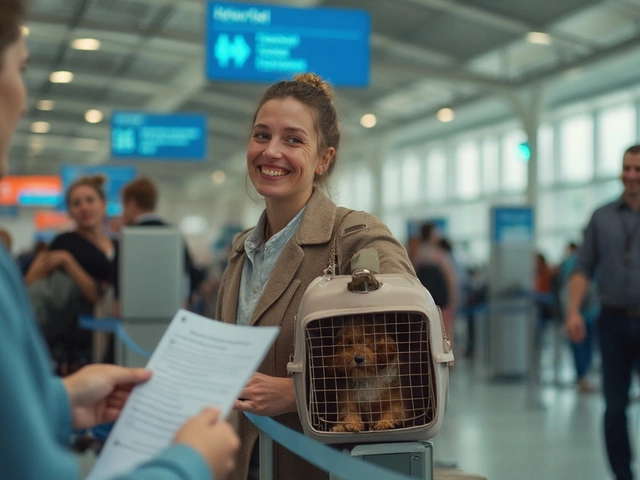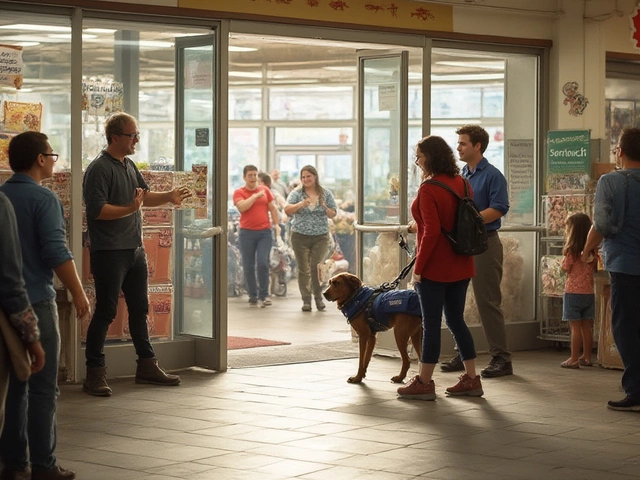If you ask ten cat owners how often they feed their cats, you’ll probably get ten different answers. Some swear by a buffet-style approach—bowl always full—while others stick to strict meal times like their cat is clocking in for work. So, how many times a day should a cat actually eat? The real answer depends on a few things, but there’s a clear sweet spot that most vets suggest.
Most grown cats do best with two meals a day, spaced out roughly 8 to 12 hours apart. Kittens? They burn through calories fast and usually need three or even four small meals daily. If your cat is acting extra hungry all the time or ignores food altogether, it could be a hint to rethink the schedule or chat with your vet. Timing matters—it helps keep their metabolism steady, their energy up, and avoids those 5 a.m. "feed me now" wake-up calls.
- Why Meal Timing Really Matters
- Kitten vs. Adult Cat: Feeding Differences
- Wet Food, Dry Food, or Both?
- Portion Sizes and Frequency
- Signs You’re Feeding Too Much (or Not Enough)
- Pro Tips for Fuss-Free Feeding
Why Meal Timing Really Matters
Most cats thrive with meals on a schedule. It’s not just about keeping your home peaceful (nobody loves the 3 a.m. yowling for kibble), but your cat’s body actually does better on a routine. When you feed your cat at the same times each day, it helps regulate their internal clock, their digestion, and even their behavior. Random feeding just doesn’t cut it for their system.
Cats are natural grazers in the wild, catching small bites throughout the day and night. But unless you have an outdoor hunter, your house cat can quickly become overweight with all-day snacking. According to the Association for Pet Obesity Prevention, over 60% of cats in the U.S. are either overweight or obese. Eating at set times helps avoid that extra weight—no surprise snacks, no mindless munching.
If your cat struggles with vomiting, scarf-and-barf (eating way too fast), or begging, mealtime structure is your best friend. Timed meals keep your cat’s metabolism running steady and make it easier to spot if your cat suddenly stops eating—a clear sign something’s wrong. Plus, if you share your home with more than one cat, feeding on a schedule helps stop food bullying and uneven weight gain.
| Age | Meals per Day | Recommended Time Gap |
|---|---|---|
| Kitten (under 6 months) | 3-4 | Every 4-6 hours |
| Adult (6 months+) | 2 | Every 8-12 hours |
| Senior (10 years+) | 2 | Every 8-12 hours |
Establishing proper cat food routines makes your life easier, too. Once your cat knows what to expect, there’s less pestering and you can quickly notice any health changes. At the end of the day, meal timing is about your cat’s health and your own sanity—win-win.
Kitten vs. Adult Cat: Feeding Differences
Kittens and adult cats have totally different needs when it comes to fueling up. A kitten’s body is in overdrive—growing bones, building muscle, and zooming around like they drank an espresso shot. They need a lot more food in smaller amounts, and more often, compared to easy-going adult cats who are mostly maintaining their fluff and attitude.
Here’s what’s really different about their feeding routines:
- Cat food for kittens is higher in protein, healthy fats, and calories. This is because their bodies just can’t keep up with adult cat food, and trying to fill them up on adult stuff stunts their growth.
- Kittens usually eat about 3-4 small meals each day. Their stomachs are tiny and can’t handle a big meal all at once.
- By the time a cat hits 12 months, you can usually drop down to two meals per day. Adult cats do great on this schedule and it helps prevent overeating.
- Senior cats—think over age 7—sometimes need a third, smaller meal if they’re having trouble keeping weight on, but always check with your vet.
Check out this quick comparison:
| Age | Meals Per Day | Special Needs |
|---|---|---|
| Under 6 months (kitten) | 3-4 | High-calorie kitten food |
| 6-12 months | 2-3 | Transitioning to adult food |
| 1+ years (adult) | 2 | Weight & portion control |
| 7+ years (senior) | 2-3 | Easy-to-eat formulas, extra hydration |
One more tip—a lot of hungry kittens will overeat if you just keep filling the bowl, so set meal times. For adults, picking up leftovers after about 30 minutes helps too. And whatever stage your cat’s at, clean, fresh water is a must, especially with dry food.
Wet Food, Dry Food, or Both?
Picking between wet food and dry food (or choosing to mix both) gets a little confusing when you see all the options at the pet store. Each has its perks and drawbacks, so let’s break it down using facts, not just what’s on the front of the bag or can.
Wet cat food usually packs more moisture, which is key for cats who don’t drink a lot of water. This helps avoid kidney and urinary tract issues, which are crazy common in cats. Plus, wet food usually smells tasty to cats, so it’s great for picky eaters or seniors who’ve lost their sense of smell. But it doesn’t last long once opened and can get more expensive over time.
Dry cat food is easy to store and perfect if you like to leave food out for your cat to snack on during the day. It’s budget-friendly and good for cats who don’t wolf down their meals in one go. However, it has less water content than wet food, so it’s not the best choice for cats who forget to drink. Watch out for overeating, too—free-feeding dry food can pile on the pounds quick.
Many people land on a mix of both. This gives your cat variety and makes feeding time more interesting. You can ditch boring routines and make sure they’re getting enough hydration without microwaving fancy meals every day. Just remember, mixing the two means you need to watch those calories. Cats are notorious for creeping up in weight when given the option to taste both all day.
Here’s a quick comparison of the main points:
| Food Type | Moisture Content | Shelf Life (When Open) | Average Cost (per day) | Best For |
|---|---|---|---|---|
| Wet Food | 70-80% | Short (a few hours) | $1.50 - $3.00 | Picky eaters, cats needing more hydration |
| Dry Food | 10-12% | Long (can be left out) | $0.10 - $0.30 | Flexible feeders, budget-conscious owners |
| Both | Balanced | Varies | $0.90 - $1.70 | Most adult cats (if you manage portions) |
If you lean toward dry, leave out small amounts and make sure your cat has fresh water close by. If you go for only wet, don’t leave it sitting out too long so you’re not inviting bacteria to dinnertime. And for the best of both worlds, a little of each at set meal times keeps your cat food routine healthy, fun, and less likely to get boring for them—or for you to clean up after.
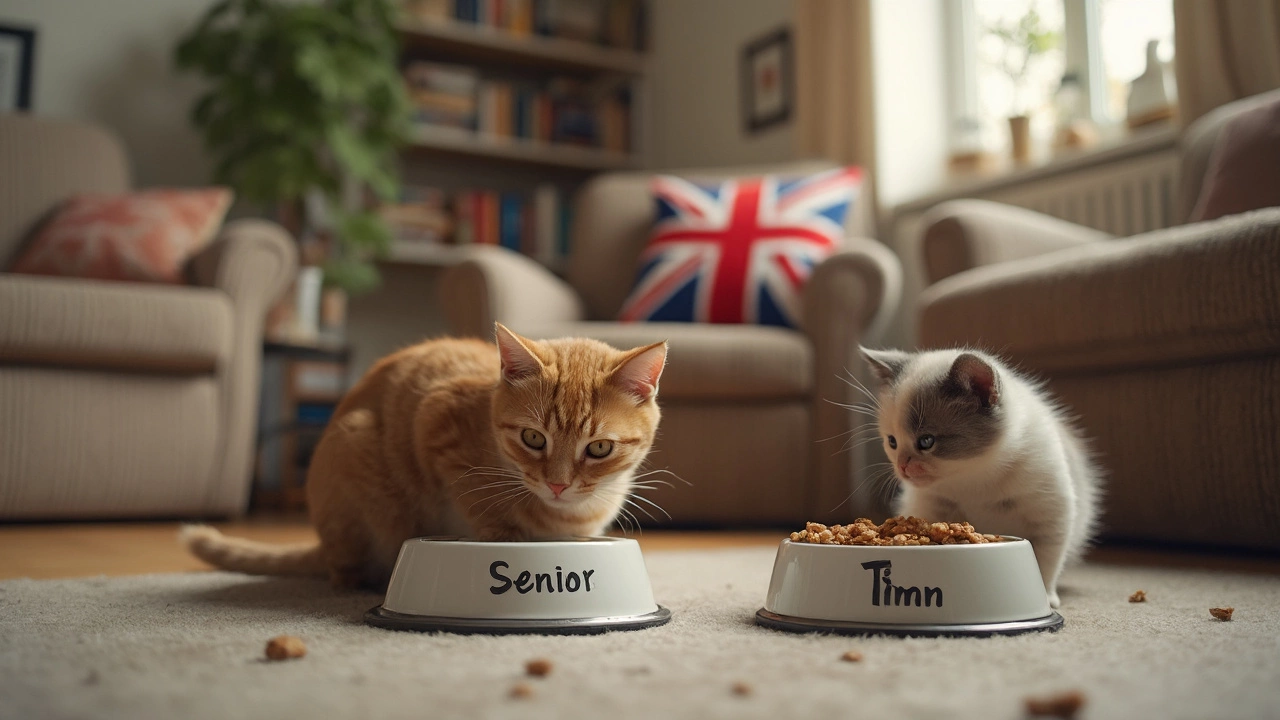
Portion Sizes and Frequency
If you’re just eyeballing how much food to toss into your cat’s bowl, you’re not alone. A lot of people do the same, but cats are pretty sensitive to overfeeding and underfeeding—even a little off can mess with their health. Here’s the lowdown on how much and how often to feed your average adult cat.
Most healthy adult cats thrive on about 24 to 35 calories per pound of body weight per day, depending on how playful or lazy they are. If your cat weighs around 10 pounds, that’s 240 to 350 calories per day, split into two meals. The packaging on commercial cat food always lists calories per cup or can, so you can actually measure it out instead of guessing.
For kittens, it’s a different game. The little ones need more calories, so they should eat three or four times a day in smaller amounts. Their bellies are tiny, but their energy is off the charts. Senior cats or cats with medical issues might need tweaks—sometimes smaller meals more often help with digestion or keeping blood sugar steady.
- Check your cat food label for calories per serving.
- Use a kitchen scale or a measuring cup to get it right, especially with dry food.
- Split daily calories into two portions (adults) or three to four (kittens or special needs).
- Adjust up or down slightly if your cat is starting to look chunky or lean.
If your cat’s part of the clean-plate club within two minutes every meal, you’re probably on track. If there’s always leftovers, you might be dishing up too much. Keeping a consistent schedule and portion size helps with cat food digestion, stops overeating, and makes it way easier to notice if your cat’s appetite changes—sometimes the first sign something’s up.
Signs You’re Feeding Too Much (or Not Enough)
Overfeeding is actually one of the most common health issues with cats. Around 60% of cats in the U.S. are overweight or obese, according to the Association for Pet Obesity Prevention. That’s not just a cosmetic issue. Carrying around extra weight can lead to diabetes, joint pain, or even liver issues for your furry friend.
How do you spot if your cat is eating too much? Watch for signs like:
- Belly that hangs low or swings when they walk
- Ribs hard to feel when you gently run your hands along their side
- Panting after very light play
- Trouble grooming, matted fur or dandruff on their back
On the flip side, if your cat isn’t eating enough, you might notice:
- Visible spine or hip bones
- Lack of energy or listlessness
- Dry, brittle coat
- More vocalizing around food and at feeding times (on the lookout for more food!)
If your cat suddenly gains or loses more than 10% of their weight without explanation, that’s a red flag. Here’s a quick look at what’s normal versus what to watch:
| Sign | Too Much Food | Too Little Food |
|---|---|---|
| Body Shape | Round, low belly | Thin, ribs visible |
| Coat Condition | Greasy, hard to groom | Dry, dull fur |
| Energy Levels | Lazy, slow to move | Weak, tired, restless |
| Appetite | Always hungry, begging | Maybe picky or obsessed with food |
Dr. Ernie Ward, founder of the Association for Pet Obesity Prevention, puts it simply:
“Cat food isn’t just about filling a bowl—it’s about fueling your cat’s life. Too much or too little and you’re setting them up for avoidable health problems.”
If you’re unsure where your cat stands, feel their sides. You should be able to easily feel (but not see) their ribs and see a slight waist behind the ribs. If in doubt, snapping a quick photo and comparing it to a ‘cat body condition chart’ found online can be surprisingly helpful.
Pro Tips for Fuss-Free Feeding
Let’s be honest, feeding cats can sometimes feel like dealing with picky toddlers. Here’s the deal: a little routine and smart choices go a long way, and that usually means fewer headaches (and less meowing at you for snacks).
- cat food: Stick to high-quality, complete food – and read the labels. Look for brands that put real meat first and avoid lots of fillers or by-products.
- Keep meal times regular. Cats love routines. Try to feed them at the same times each day. This helps their digestion and makes life more predictable for both of you.
- Don’t leave food out all day, unless you’re dealing with a super skinny cat or your vet advised otherwise. Free-feeding leads to chubby kitties – and more vet visits down the road.
- Make sure the food and water bowls are clean. Dirty dishes? Cats might skip meals just because of that. Clean bowls also help prevent bacteria build-up and bad smells.
- If you’ve got more than one cat, space out their bowls. Dominant cats might hog the food, leaving others hungry. Give everyone their own space so meal times don’t turn into a wrestling match.
- Pay attention to what your cat actually eats. If you’re changing foods, go slow. Mix the new food into the old for about a week to avoid stomach issues.
- Add variety, but do it safely. Rotating between wet and dry food helps with hydration and can make meal times more exciting. Just don’t switch things up too fast.
Check out this quick comparison of how cats fed on different schedules fare when it comes to weight and health:
| Feeding Style | Average Weight Gain (per year) | Reported Health Issues |
|---|---|---|
| Free-Feeding (Food Always Available) | +1.2 lbs | Obesity, picky eating |
| Scheduled Meals (Twice Daily) | +0.4 lbs | Stable weight, better portion control |
| Once Daily | -0.2 lbs | Begging, occasional overeating |
One last thing: fresh water matters as much as food. Cats aren't always big drinkers, so put water bowls in a few spots around the house, including away from their food, since some cats hate eating beside their water. If your cat acts fussy, try different shaped bowls, or even a pet fountain—some cats just love moving water.

